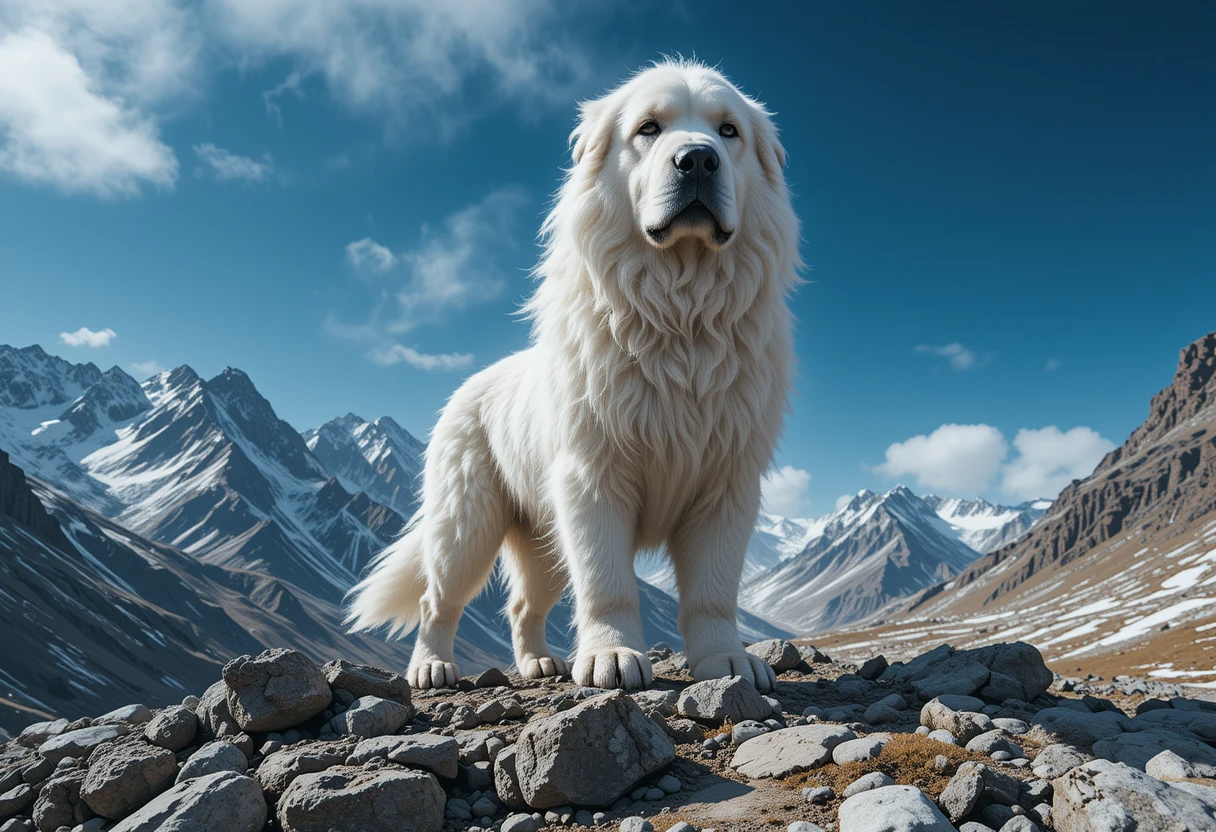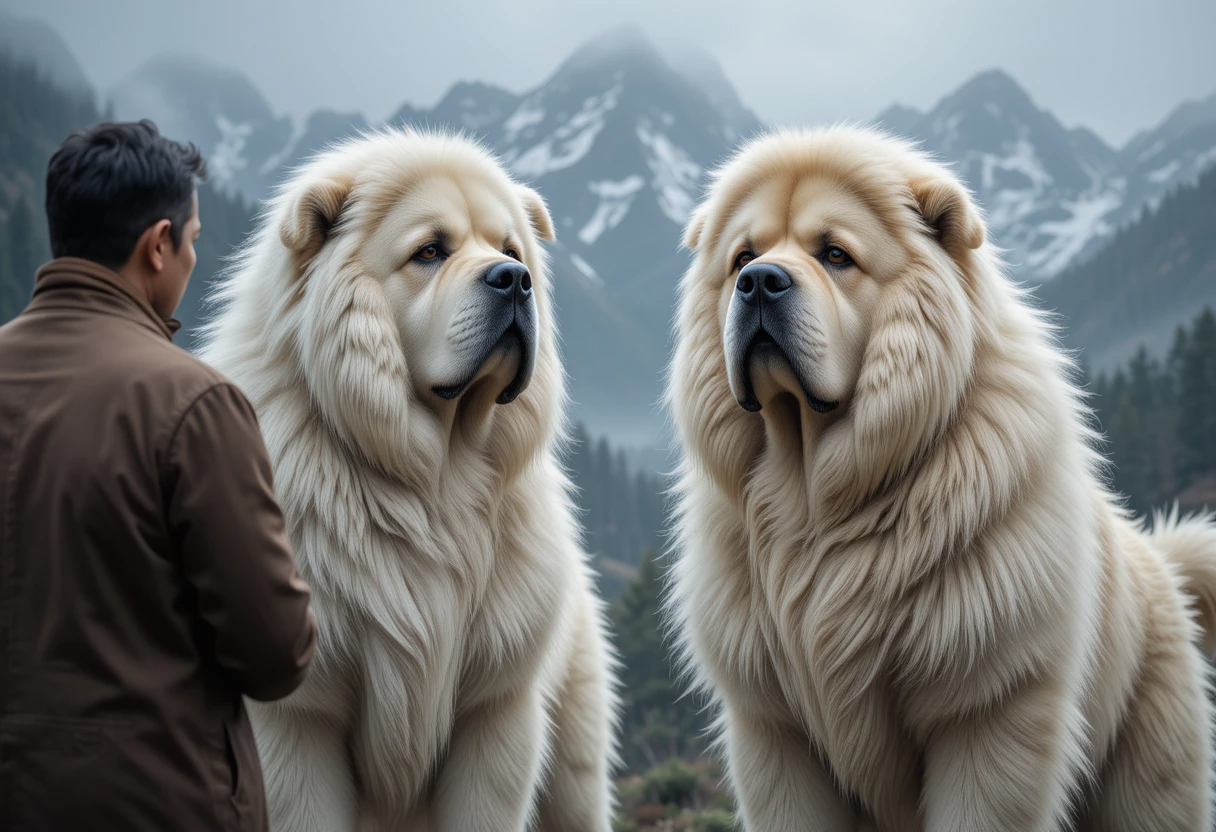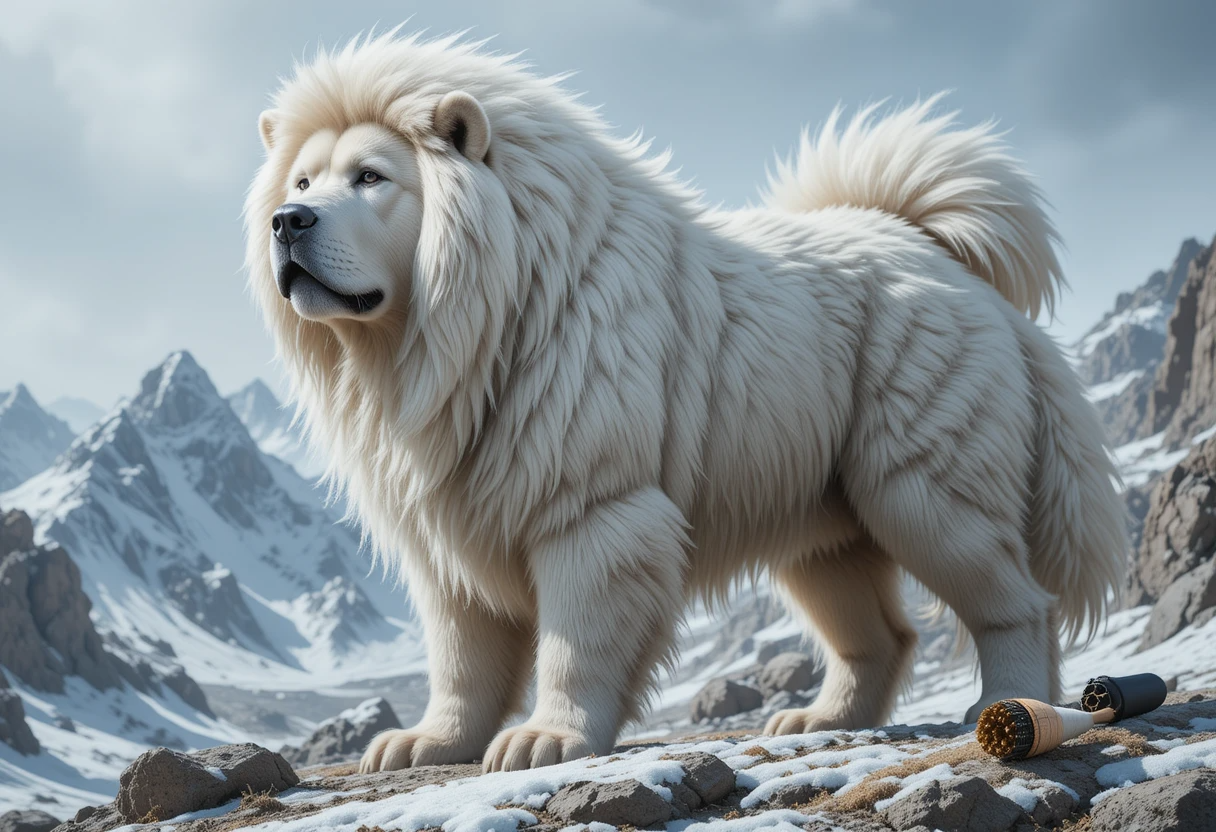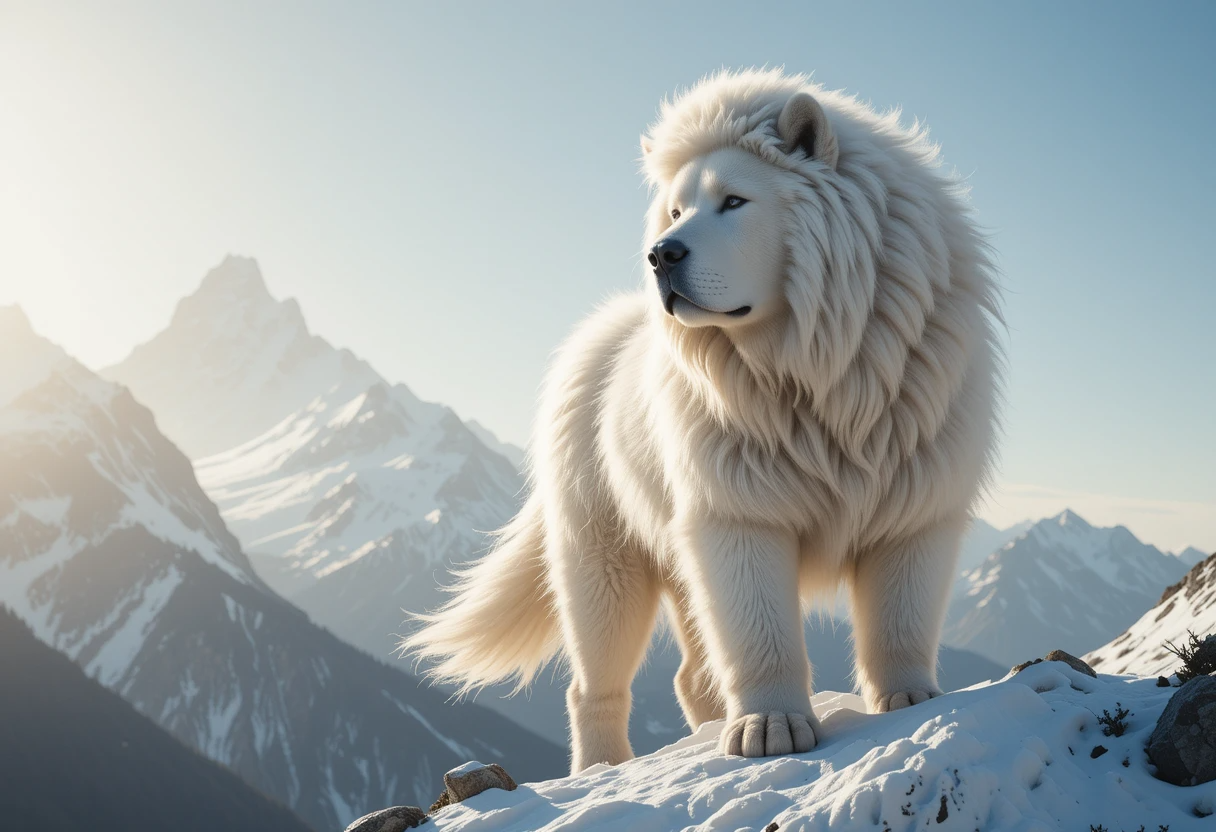The white giant Tibetan Mastiff stands as one of the most magnificent and controversial dogs in the canine world. This extraordinary breed combines the ancient heritage of Tibetan guardians with the striking beauty of a pristine white coat, creating a dog that is both breathtaking and enigmatic. As one of the most expensive and rarest color variations of the Tibetan Mastiff, the white giant Tibetan Mastiff has captured the imagination of dog enthusiasts worldwide while sparking heated debates among breed experts.
Originally bred in the harsh, high-altitude environments of Tibet, these massive dogs were developed to guard Buddhist monasteries and protect nomadic families from predators like wolves and snow leopards. The white giant Tibetan Mastiff represents a fascinating chapter in this ancient breed’s story, though its authenticity remains a subject of passionate discussion in breeding circles.
In this comprehensive guide, we’ll explore everything you need to know about the white giant Tibetan Mastiff, from its disputed origins and unique characteristics to care requirements and the controversy surrounding its existence. Whether you’re considering adding one of these magnificent dogs to your family or simply fascinated by this remarkable breed, this article will provide you with expert insights and practical information.
Understanding the White Giant Tibetan Mastiff

The Ancient Heritage of Tibetan Mastiffs
The Tibetan Mastiff, known in Tibet as “Do-Kyi” meaning “tied dog,” represents one of the world’s most ancient dog breeds. Archaeological evidence suggests these magnificent guardians have protected Tibetan families for over 5,000 years, with some genetic studies indicating their lineage may extend back 58,000 years to their separation from gray wolves American Kennel Club.
These remarkable dogs evolved in the Chang Tang Plateau of Tibet, where the average altitude reaches 16,000 feet. This extreme environment shaped their distinctive characteristics: the thick double coat that protects against sub-zero temperatures, the massive size that intimidates predators, and the independent temperament that allows them to make split-second decisions while guarding their charges.
What Makes the White Giant Tibetan Mastiff Special
The white giant Tibetan Mastiff represents a unique color variation within this ancient breed. While traditional Tibetan Mastiffs come in colors like black, brown, gold, and blue-gray, the white variety has emerged as perhaps the most sought-after and expensive. These dogs typically weigh between 90-150 pounds for males and 70-120 pounds for females, with heights ranging from 26-30 inches at the shoulder.
What sets the white giant Tibetan Mastiff apart is not just its stunning appearance, but also its rarity. The pristine white coat, combined with proper black pigmentation around the nose and eyes, creates a striking contrast that has made these dogs highly prized, particularly in Chinese markets where some specimens have sold for millions of dollars.
The Controversy Surrounding White Giant Tibetan Mastiffs

The Great White Debate
The existence of authentic white giant Tibetan Mastiffs has become one of the most contentious topics in the dog breeding world. According to breed experts, the controversy centers on whether these dogs are genuine Tibetan Mastiffs or the result of crossbreeding with other white guardian breeds.
Rick Eichhorn, a renowned Tibetan Mastiff expert and breeder from Drakyi Tibetan Mastiffs, argues that “there’s no such thing as a white Tibetan Mastiff in Tibet.” He suggests that the white coloration likely results from crossbreeding with breeds like the Great Pyrenees, Anatolian Shepherd, or Russian Ovcharka breeds that are readily available at the Chinese-Russian border Modern Molosser.
The Chinese Market Influence
The explosive popularity of Tibetan Mastiffs in China has driven unprecedented demand for unusual color variations, including white. This market pressure has led some breeders to push beyond traditional breed standards in terms of size, color, and even temperament. The cultural fascination with white coats in China, similar to what Eichhorn observed in Pekingese breeding, has created a lucrative market for white giant Tibetan Mastiffs.
However, supporters of white Tibetan Mastiffs, like breeder Suzanne Merrill of Snow Lion Tibetan Mastiffs, maintain that these dogs are authentic. She imported breeding pairs from China in 2008 and has produced white offspring. DNA testing on some of these dogs has reportedly shown 100% Tibetan Mastiff genetics, though this remains disputed by traditional breeders.
Distinguishing Authentic White from Dilute Gold
One crucial aspect of the white giant Tibetan Mastiff controversy involves distinguishing between true white dogs and dilute gold specimens. Authentic white Tibetan Mastiffs should have:
- Pure white coats with no warm undertones
- Black nose pigmentation
- Dark eyes with proper pigmentation
- No biscuit or cream coloring on the ears
In contrast, dilute gold dogs that may appear white from a distance typically display:
- Cream or warm-toned coats
- Brown or flesh-colored noses
- Lighter ear coloration
- A slightly dirty or off-white appearance
Physical Characteristics and Temperament

Size and Appearance
The white giant Tibetan Mastiff is truly a sight to behold. Males typically stand 26-30 inches tall and weigh 90-150 pounds, while females are slightly smaller at 24-28 inches and 70-120 pounds. Their massive, well-proportioned bodies are covered in a thick double coat that serves as protection against extreme weather conditions.
The breed’s head is one of its most distinctive features, with a broad skull, well-defined stop, and a short, square muzzle. Their small, triangular ears hang close to the head, and their eyes are medium-sized and deeply set, expressing intelligence and alertness. The tail is feathered and curves over the back, adding to their regal appearance.
Coat and Grooming Requirements
The white giant Tibetan Mastiff’s most striking feature is its magnificent double coat. The outer coat consists of coarse guard hairs, while the undercoat is soft and woolly. This combination provides excellent insulation against both cold and heat, though these dogs are better suited to cooler climates.
Unlike many breeds that shed year-round, Tibetan Mastiffs “blow” their coat once annually, typically in spring. During this period, they shed their entire undercoat, which can be quite dramatic. Regular brushing is essential during shedding season, potentially requiring daily attention. During non-shedding periods, weekly brushing is usually sufficient to maintain their coat’s health and appearance.
Temperament and Personality
The white giant Tibetan Mastiff inherits the traditional temperament of its ancestors: independent, protective, and deeply loyal to family members. These dogs are naturally aloof with strangers, a trait that made them excellent guardians in their native Tibet. They possess an almost uncanny ability to assess situations and people, making them excellent judge of character.
Key temperament traits include:
- Protective Instincts: Naturally suspicious of strangers and highly protective of their territory
- Independence: Capable of making decisions without human guidance
- Loyalty: Deeply devoted to family members
- Intelligence: Highly intelligent but can be stubborn
- Calmness: Generally calm and composed in familiar environments
However, some experts suggest that white giant Tibetan Mastiffs may display slightly different temperamental characteristics, potentially due to crossbreeding influences. These dogs might be more prone to barking and may have a more active, less patient demeanor compared to traditional Tibetan Mastiffs.
Explore our detailed guide on the Best Chinese Tibetan Mastiff Breeders 2025 to find reputable sources for this majestic breed.
Care and Maintenance
Exercise Requirements
Despite their large size, white giant Tibetan Mastiffs have moderate exercise needs. They were bred to patrol and guard rather than to engage in high-energy activities for extended periods. A daily walk combined with some playtime in a securely fenced yard is typically sufficient for most adults.
These dogs prefer meaningful activities over simple exercise. They excel at:
- Patrol walks around their territory
- Interactive play sessions with family members
- Mental stimulation through training and puzzle toys
- Supervised exploration of new environments
Feeding and Nutrition
The white giant Tibetan Mastiff requires a high-quality diet appropriate for large breed dogs. Adults typically consume 4-6 cups of dry food daily, divided into two meals. The exact amount depends on the dog’s age, size, activity level, and metabolism.
Key nutritional considerations include:
- Protein: High-quality protein sources to support muscle development
- Controlled Calcium: Appropriate calcium levels to prevent developmental issues
- Glucosamine: Joint support supplements for large breed health
- Omega Fatty Acids: For coat health and skin condition
Annual food costs can range from $500-$1,000, depending on the quality of food chosen and the dog’s individual needs.
Health Considerations
White giant Tibetan Mastiffs, like all large breeds, are susceptible to certain health conditions. Common concerns include:
Hip and Elbow Dysplasia: Genetic conditions affecting joint development that can lead to arthritis and mobility issues.
Progressive Retinal Atrophy (PRA): An inherited eye condition that can lead to blindness.
Hypothyroidism: A thyroid condition that can affect metabolism and coat quality.
Bloat (Gastric Dilatation-Volvulus): A life-threatening condition common in large, deep-chested breeds.
Inherited Myopathy: A muscle disorder that can affect young dogs.
Regular veterinary check-ups, genetic testing of breeding dogs, and maintaining proper weight are essential for preventing or managing these conditions.
Training and Socialization
Early Socialization
Proper socialization is crucial for white giant Tibetan Mastiffs due to their naturally protective instincts. Early exposure to various people, animals, environments, and situations helps develop a well-balanced adult dog. This process should begin as early as possible and continue throughout the dog’s life.
Effective socialization strategies include:
- Puppy kindergarten classes
- Controlled exposure to different people and animals
- Regular outings to various environments
- Positive experiences with handling and grooming
- Introduction to different sounds, sights, and smells
Training Challenges and Approaches
Training a white giant Tibetan Mastiff requires patience, consistency, and understanding of their independent nature. These dogs were bred to work independently, making them naturally less inclined to follow commands without question.
Successful training approaches include:
Positive Reinforcement: Reward-based training methods work best with this breed’s sensitive nature.
Consistency: All family members must enforce the same rules and commands.
Early Start: Begin training as early as possible, preferably during puppyhood.
Respect for Independence: Acknowledge their decision-making abilities while maintaining leadership.
Professional Help: Consider working with experienced trainers familiar with guardian breeds.
Also read: Are Great Danes Good With Small Kids – find out if this gentle giant fits into your family with little ones.
The Economics of White Giant Tibetan Mastiff Ownership
Initial Purchase Costs
The white giant Tibetan Mastiff ranks among the world’s most expensive dog breeds. Purchase prices can vary dramatically based on several factors:
- Bloodline Quality: Dogs from champion bloodlines command premium prices
- Geographic Location: Prices vary significantly by region
- Breeder Reputation: Established breeders typically charge more
- Registration Status: AKC-registered dogs cost more than unregistered ones
Typical price ranges include:
- Pet Quality: $3,000-$8,000
- Breeding Quality: $8,000-$15,000
- Show Quality: $15,000-$30,000+
- Exceptional Specimens: $50,000-$100,000+
In China, where the breed has reached celebrity status, prices have reached astronomical levels, with some white giant Tibetan Mastiffs selling for over $1 million.
Ongoing Ownership Costs
Beyond the initial purchase price, white giant Tibetan Mastiff ownership involves substantial ongoing expenses:
Monthly Costs (estimated):
- Food: $80-$120
- Veterinary Care: $100-$200
- Grooming: $50-$100
- Insurance: $80-$150
- Miscellaneous: $50-$100
Annual Costs (estimated):
- Total: $4,000-$8,000
Lifetime Costs (10-12 years):
- Total: $40,000-$80,000
These figures don’t include emergency veterinary care, which can be substantial for large breeds prone to serious health conditions.
Breeding and Genetics
Genetic Considerations
The genetics behind the white coat in Tibetan Mastiffs remains a subject of scientific study and debate. Traditional coat colors in Tibetan Mastiffs are controlled by well-understood genetic mechanisms, but the white coloration presents unique challenges.
Genetic factors affecting coat color include:
- Piebald Gene (S Locus): Controls white spotting patterns
- Dilution Genes: Can lighten base coat colors
- Extension Gene (E Locus): Affects pigment production
- Agouti Gene (A Locus): Controls color distribution
Breeding Challenges
Breeding white giant Tibetan Mastiffs presents several unique challenges:
Limited Gene Pool: The small number of breeding-quality white dogs limits genetic diversity.
Health Testing: Extensive health screening is essential due to the breed’s susceptibility to genetic conditions.
Temperament Consistency: Maintaining the traditional Tibetan Mastiff temperament while breeding for color.
Authenticity Questions: Ensuring breeding dogs are genuinely purebred Tibetan Mastiffs.
Responsible Breeding Practices
Ethical breeders of white giant Tibetan Mastiffs should:
- Conduct comprehensive health testing on all breeding dogs
- Maintain detailed records of lineage and health history
- Provide lifelong support to puppy buyers
- Prioritize temperament and health over appearance
- Be transparent about the breed’s controversial status
Legal and Ethical Considerations
Breed Restrictions
Potential owners should be aware that Tibetan Mastiffs, including white varieties, face restrictions in some areas due to their size and protective nature. Some jurisdictions classify them as dangerous breeds or require special permits for ownership.
Ethical Ownership Responsibilities
Owning a white giant Tibetan Mastiff comes with significant ethical responsibilities:
Proper Containment: Secure fencing and proper restraint are essential for public safety.
Adequate Space: These dogs require sufficient space to patrol and exercise.
Lifelong Commitment: The breed’s long lifespan and substantial care requirements demand a serious commitment.
Professional Training: Many owners benefit from professional training assistance.
Insurance Coverage: Liability insurance is often necessary due to the breed’s size and protective nature.
FAQs
The authenticity of white giant Tibetan Mastiffs remains hotly debated among breed experts. While some breeders claim to have authentic white Tibetan Mastiffs with DNA testing to support their claims, many traditional breeders argue that true white coloration doesn’t exist in authentic Tibetan Mastiffs from Tibet. The controversy stems from the breed’s explosive popularity in China, where crossbreeding with white guardian breeds like Great Pyrenees or Russian Ovcharkas may have introduced the white gene. Prospective buyers should research bloodlines carefully and work with reputable breeders who can provide documentation of their dogs’ authenticity. Are White Giant Tibetan Mastiffs Real or Fake?
How Much Does a White Giant Tibetan Mastiff Cost?
White giant Tibetan Mastiffs are among the world’s most expensive dogs, with prices ranging from $3,000 for pet-quality dogs to over $100,000 for exceptional specimens. In China, where the breed has reached celebrity status, prices have reached astronomical levels, with some white Tibetan Mastiffs selling for over $1 million. The high cost reflects their rarity, the expense of importing breeding stock, and the substantial costs associated with raising these giant dogs. Potential owners should also budget for ongoing costs of $4,000-$8,000 annually for proper care and maintenance.
What Size Do White Giant Tibetan Mastiffs Reach?
White giant Tibetan Mastiffs are truly massive dogs, with males typically reaching 26-30 inches in height and weighing 90-150 pounds. Females are slightly smaller, standing 24-28 inches tall and weighing 70-120 pounds. Some exceptional specimens may exceed these ranges, with the largest individuals weighing over 200 pounds. Their size, combined with their thick double coat, creates an imposing presence that served them well as guardians in their native Tibet. However, their large size also means they require substantial space, specialized veterinary care, and significant resources for proper care.
How Long Do White Giant Tibetan Mastiffs Live?
White giant Tibetan Mastiffs typically live 10-12 years, which is relatively good for a giant breed. Their lifespan can be influenced by various factors including genetics, diet, exercise, and healthcare. Responsible breeding practices that include health testing for genetic conditions can help improve longevity. Common health concerns that may affect lifespan include hip dysplasia, progressive retinal atrophy, hypothyroidism, and bloat. Regular veterinary care, maintaining proper weight, and providing appropriate exercise can help maximize their lifespan and quality of life.
Are White Giant Tibetan Mastiffs Good Family Dogs?
White giant Tibetan Mastiffs can be excellent family dogs for the right households, but they’re not suitable for everyone. They form deep bonds with their families and are particularly protective of children. However, their size, protective instincts, and independent nature require experienced dog owners who can provide proper training and socialization. They need early socialization to prevent over-protectiveness and may be aloof with strangers. These dogs require substantial space, consistent training, and owners who understand guardian breed characteristics. They’re better suited to experienced dog owners rather than first-time pet parents.
Conclusion
The white giant Tibetan Mastiff represents one of the most fascinating and controversial dogs in the modern canine world. Whether viewed as a rare treasure or a questionable hybrid, these magnificent dogs continue to capture hearts and spark debates among dog enthusiasts worldwide.
For those considering adding a white giant Tibetan Mastiff to their family, the decision should not be taken lightly. These dogs require experienced owners who can provide proper training, socialization, and care. The substantial financial investment extends far beyond the initial purchase price, encompassing years of specialized care, training, and veterinary expenses.
The controversy surrounding their authenticity serves as a reminder of the importance of working with reputable breeders who prioritize health, temperament, and breed integrity over profit. Whether white giant Tibetan Mastiffs are authentic ancient guardians or modern creations, they undeniably possess the majesty and presence that has made Tibetan Mastiffs legendary.
As the debate continues within breeding circles, one thing remains clear: the white giant Tibetan Mastiff stands as a testament to the enduring appeal of these magnificent guardians from the roof of the world. Their story reflects broader themes in modern dog breeding, including the tension between tradition and innovation, the impact of market forces on breed development, and the ongoing responsibility of breeders and owners to preserve the health and integrity of these remarkable dogs.
For those fortunate enough to share their lives with these extraordinary animals, the white giant Tibetan Mastiff offers a unique combination of ancient wisdom, loyal companionship, and breathtaking beauty that few other breeds can match.

